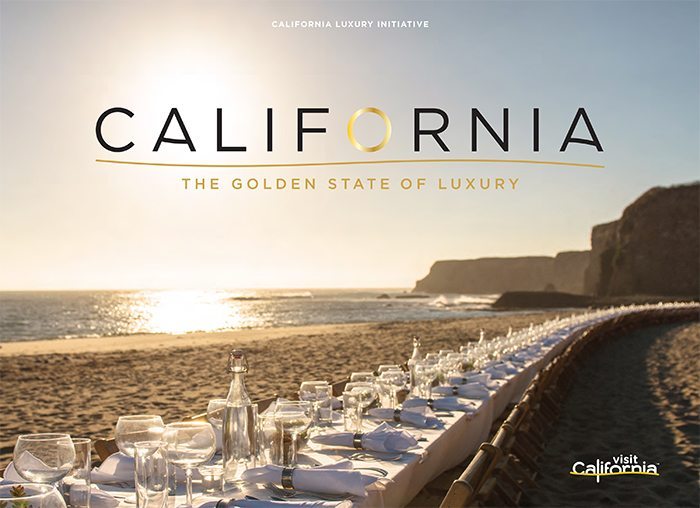Skift Take
Visit California developed an integrated research and content framework to support its travel and media partners' ability to better engage luxury consumers than it can do alone on its own brand.com website and paid marketing platforms.
Visit California just released a new comprehensive strategy paper and branded content platform designed to engage next-generation “Super Affluent” travelers with a household income north of $250,000.
The destination marketing initiative, called “California: The Golden State of Luxury,” was rolled out at the International Luxury Travel Market (ILTM) this week in Cannes with a new video produced specifically for travel industry members.
The thrust of the business-to-business branding mission promotes California’s version of what it calls “laid-back luxury.” It’s an evolving definition of luxury championing aspirational and healthy travel experiences revolving around local food, outdoor experiences, and luxury resorts and spas, but without the pretense and showy hubris often associated with the luxury segment.
The introduction of the Golden State of Luxury research paper states: “Compared to the luxury goods product category, destinations appear less likely to create distinct or differentiated positioning targeted specifically to a luxury audience.”
Meaning, most tourism bureaus in destinations with luxury hotels, fine-dining, and upscale shopping tend to still promote themselves to all budget segments to increase overall exposure. Only a select few in North America such as the Beverly Hills Conference & Visitors Bureau exclusively target high-end visitors, illustrated by Beverly Hills’ “Future of Luxury” research and marketing report developed earlier this year. That report partially inspired and informed the development of the Golden State of Luxury paper.
However, Visit California isn’t trying to brand the state as a luxury-only destination.
It’s attempting to communicate more directly to its top-tier travel agent and tour operator partners that California was the birthplace of modern luxury travel as we know it today. One could argue that the rise of 21st century luxury hospitality and tourism in North America began to take shape about three decades ago in California’s culinary scene along the Pacific coast between Monterey and Napa Valley.
U.S. winemakers in the region were beginning to compete successfully with top European wineries for the first time back in the early 1980s. Likewise, California pretty much invented farm-to-table fine-dining experiences, aligned with the rise of artisanal food and wine festivals, outdoor farmers’ markets, organic food production, and the U.S. celebrity chef phenomenon. Amid that shift, small luxury resorts opened outside the major urban centers with a greater appreciation for the outdoors, and guest wellness in general, to provide the appropriate environment for this culinary new modernism.
In effect, 30 years ago, California’s central coast was developing a food-and-beverage-driven luxury travel positioning that was healthier and more experiential, outdoorsy, down-to-earth, and environmentally friendly. That is essentially what has since evolved into the mainstream luxury travel market today, as other destinations spent the last decade playing catch-up.
Caroline Beteta, CEO of Visit California, feels that the state overall has a built-in competitive advantage that it needs to leverage more aggressively to engage today’s luxury travel consumer who takes all of the above elements mostly for granted. She said that Super Affluent travelers only make up three percent of the consumer base visiting the state, but they account for 14 percent of total revenue. So it’s important for Visit California and its partners to be on the same page to collectively differentiate the product from other destinations.
“We spent the last year and a half doing a lot of research proving that the California luxury experience is something completely different,” Beteta explained. “Though not lacking any luxuries, it’s more of a luxury without pretense, or laid-back luxury, and it’s a different approach. The research was basically telling ourselves what we instinctively already understood — that California is discernible between other world-class luxury destinations.”
The Growing Impact of Branded Content
The Golden State of Luxury research states that superior quality, authenticity, exclusivity, and meaningful experiences are the primary motivators that impact travel purchase decisions for Visit California’s Super Affluent target audiences in the U.S., Canada and the U.K. Those destinations were chosen for the rollout of this initiative because they have the highest percentage of wealthy customers in existing high-priority source markets.
The tourism bureau’s strategy then layers four primary travel product experiences over those four main motivational triggers listed above. They include: Culinary, Outdoor, Resorts, and Spas, all of which individually and combined support the report’s stated mantra: “Experience is the new status symbol.”
Those product experiences were chosen because Visit California has an inordinately high and widespread wealth of hospitality partners across the state that offer all four experience at high industry standards. Driving business to those partners also helps disperse visitation beyond the state’s iconic attractions to extend time in-destination and increase average customer spend.
The report further breaks down the motivators that drive higher booking conversion rates among Millennial versus Gen X/Boomer Super Affluent travelers. Although, the paper states that there is more that unites the ages than separates them, including high disposable income, a passion for travel, and a drive to live life to the fullest by seeking out new experiences.
The most interesting takeaway from the research emphasizes the power of high-quality branded content and native advertising to influence Super Affluents to book travel destinations, especially when it originates from third-party media companies versus Visit California’s owned channels. That’s because consumers are more likely to share content on those channels, and more likely to trust that content.
A significant portion of the white paper is dedicated to describing the effectiveness that Visit California attributes to branded content. The report reads:
“The Super Affluent audience continues to demonstrate stable readership and affinity for print magazines and luxury-focused niche digital platforms. Sponsored/native content is a newer digital tactic that luxury brands are increasingly using to create engagement with luxury consumers. Research and expert opinion affirms that sponsored/native content is an approach well suited to luxury audiences, and when employed correctly can be a very effective medium with this discerning audience.”
That’s why consumers won’t see the Golden State of Luxury messaging on the Visit California website.
Instead, the tourism bureau is partnering with media companies for different series of branded content, including Conde Nast titles such as Conde Nast Traveler, Bon Appetit, The New Yorker, Vanity Fair, and Vogue; and Time Inc. brands including Departures, Fortune, and Travel+Leisure. One example is this T+L digital platform called “The New Gold Rush.” The messaging on that page above the three editorial buckets profiling celebrity Californians sums up Visit California’s overall laid-back luxury strategy:
“In California, luxury is personal and unburdened by stuffy or staid traditions. Its culture embraces a relaxed approach to the elevated that is free of pretense, but full of passion, enthusiasm, and discovery. Follow along as three well-known residents explain why Californian luxury is more than an experience — it’s a state of mind.”
Expanded Content & Trade Partnerships
When Visit California relaunched its website in January 2015, it ushered in a new era of developing destination marketing portals that resembled travel magazine websites more than promotional billboards filled with hotel lists and web banners.
The strategy is based on the power of quality editorial content to attract viewers, who the Visit California website then pushes to its partners through content sections embedded in the primary storytelling landing pages.
According to Beteta, the tourism bureau has “handed off” customers over two million times to California travel companies, and social shares have jumped more than 1,600 percent since January 2015, compared to the previous Visit California website. Also, she said unique visitor figures have increased by 91 percent in 2016 over 2015.
For now, the website’s Luxury Travel landing page displays a convergence of content showcasing a revolving mix of destination, hotel, activity, and local Californian profile content.
With the launch of the Golden State of Luxury initiative, there is now a new Transcendent California Experiences landing page that is invisible on the website unless users have the URL. Presently, the page features a profile on Annie Lawless, a California resident who created an organic juice brand. There are also two blogs posts highlighting luxury resorts and spas.
The role of the two luxury pages will grow to promote the state of California as a luxury destination to the travel industry and consumers, versus a destination with numerous luxury travel communities.
“When you really talk to the trade, they say, ‘We don’t necessarily think of California top-of-mind when it comes to luxury, like we do when we think about Beverly Hills or Orange County,'” said Lynn Carpenter, VP of marketing at Visit California. “So I think our primary marketing challenge is to package California as a luxury travel experience and find a place to house that and promote it. Right now, our media partners are carrying that message exclusively, but that will evolve as we move forward.”
The Transcendent page could potentially be password-protected at some point, or made exclusive in some other way, to provide added value for Visit California partners and high-spending repeat luxury travelers. Ostensibly, the content could evolve into some kind of loyalty program where repeat customers are provided exclusive incentives, but nothing has been decided at this time.
“It’s a little bit of an experiment,” Carpenter said. “It’s a hidden URL right now, because the idea is that travel agents who are selling to high net-worth individuals can give their clients something that isn’t generally available. That will grow over time to include more exclusive content.”
Visit California is also expanding its collaboration with tour operators and travel trade organizations and events to better engage travel advisors selling luxury travel packages.
For example, the organization is supporting the entrance of U.K.-based Turquoise Holidays into the U.S. market by developing proprietary, California-specific programs aligned around the laid-back luxury lifestyle.
As well, the state agency is increasing its participation in luxury travel trade events, such as ILTM, Virtuoso Travel Week, ULTRA Summit and Arabian Travel Market.
It will also, for the first time ever, bring a contingent of luxury hotel partners to the annual PURE Life Experience buyer/supplier tradeshow in Marrakech, which Skift covered this year.
“We’ve spent an enormous amount of time with some of our partners,” said Beteta. “We wanted to go deeper, and really understand the luxury consumer mindset and really partake in these experiences. The purveyors, the operations folks, owners, managers — they are the ones who really have their head wrapped around the nuance of some of our luxury travel experiences in California.”
The Daily Newsletter
Our daily coverage of the global travel industry. Written by editors and analysts from across Skift’s brands.
Have a confidential tip for Skift? Get in touch
Tags: california, marketing
Photo credit: Organic juice company founder Annie Lawless is profiled in Visit California's new "Golden State of Luxury" trade campaign. Visit California

